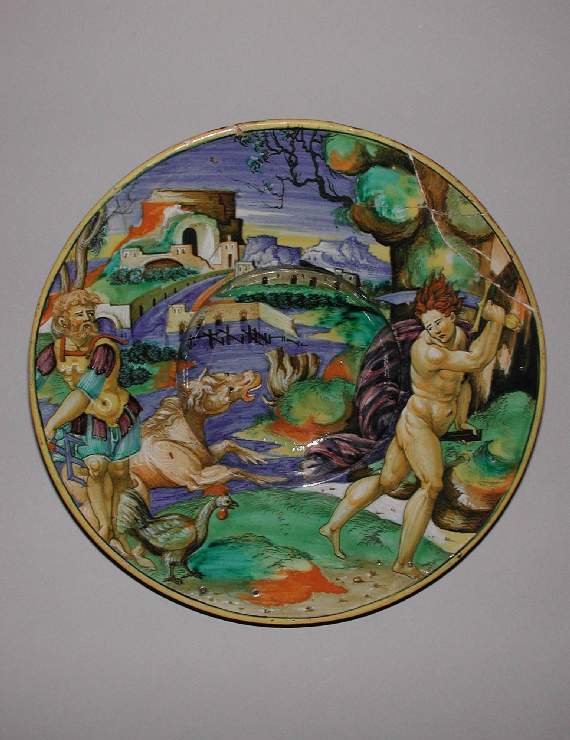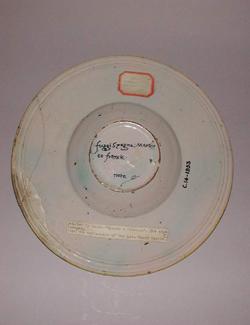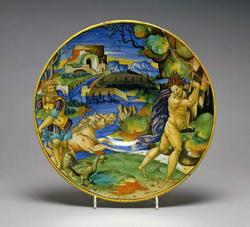Current Location: Gallery 7 (Courtauld)
Titles
A Political Allegory
Maker(s)
Painter:
Avelli, Francesco Xanto
(Probably)
Printmaker:
Raimondi, Marcantonio
(After)
Printmaker:
Dente, Marco (Marco da Ravenna)
(After)
Entities
Categories
Description
Maiolica dish, painted in polychrome with A Political Allegory.
Buff earthenware, tin-glazed overall; the reverse greyish and tinged with green. Painted in blue, green, turquoise, yellow, orange, stone, brown, manganese-purple, black, and white.
Shape 57. Circular with a wide, slightly sloping rim and small, deep well; the underside of the rim moulded with three bands of reeding.
A Political Allegory. A man in armour all'antica holding a trident stands on the left accompanied by a horse and a cock. On the right, a nude man with a billowing cloak is poised to make a blow with a curved sword held in his right hand. In the foreground there is a pebbly path and grass; on the right, rocks and a tree; and in the background, a river running past fortifications towards distant mountains. The edge is yellow. The back is inscribed in the middle in dark blue: `fuggi spagna: Marcho/et francia./nota y' (flee Spain: Mark and France. take note y).
Notes
History note: Henry Harris; Sotheby's, 20 June 1950, Catalogue of fine Italian maiolica from the well-known collection of the late Henry Harris, Esq. . . ., lot 110; Alfred Spero; Marmaduke Langdale Horn (1889-1953).
Legal notes
M.L. Horn Bequest
Measurements and weight
Diameter: 27 cm
Height: 4.5 cm
Acquisition and important dates
Method of acquisition: Bequeathed
(1953-10-22)
by
Horn, Marmaduke Langdale
Dating
16th Century, second quarter
Renaissance
Circa
1528
CE
-
1530
CE
Note
Dishes signed with a y or phi are considered on stylistic grounds to have been painted by Francesco Xanto Avelli from Rovigo in the Vento, whose presence in Urbino is documented between 1530 and 1542. Apart from his distinctive style, Xanto's work is remarkable in several ways.
Most maiolica painters derived their designs from prints or book illustrations, but Xanto carried their use beyond ingenuity to repetitiousness. His deployment of a now well-defined group of prints as 'figure banks' from which to construct scenes resulted in wide variations in the quality of his work. Many of his compositions are highly successful, but others are extremely awkward with little relationship between the figures. The figures on this dish were taken from two prints of the 'Massacre of the Innocents': the nude man whielding the sword from the engraving by Marcantonio Raimondi after Raphael (Bartsch XIV, p. 19, no. 18; Illustrated Bartsch, 26, 1978, p. 33, no. 21), and the man with the trident from the version by Marco Dente after Baccio Bandinelli (Bartsch XIV, p. 24, no. 21; Illustrated Bartsch, 26, 1978, p. 33, no. 21).
His obsession with the dramatic and terrible political events of the late 1520s and early 1530s, singles him out from his contemporaries. Many of this dishes are decorated with political allegories with pro-imperial, anti-papal, or anti-Medicean themes connected with the Sack of Rome in 1527, and some have a violent, sadistic quality which is entirely absent from the work of other maiolica painters.Interest has necessarily centred on the interpretation of these thems and what they reveal about Xanto. It may never be known whether his patrons (or perhaps more correctly, his employer's patrons) ordered these political subjects, or whether Xanto included them at his own discretion in services or sets of mythological, historical, or religious subjects, such as the Three Crescents service, and the Pucci service (See C.10-1953 and C.11-1953).
Xanto appears to have been more highly educated than the other maiolica painters in Urbino, and displayed his erudition by inscribing both the title and the literary sources of his compositions on the verse of dishes. These mainly refer to translations of Latin works, or to poetry by Petrarch or Ariosto. He also signed his name or initials much more frequently than any other painter. In the late 1530s however, he became more casual, often using 'Xanto', 'X.X.A.R.' or just 'X'. The sign resembling a y or phi sign in Greek occurs on plates bearing his signature, and more rarely on ones with the signature of his associates, such as Giulio da Urbino. The sign often follows the word 'nota' as here, or 'historia' or 'fabula' painted, which date from about 1527 to 1530. Its meaning is unclear, but it seems to be used as an abbreviation instead of completing a citation.
School or Style
Renaissance
People, subjects and objects depicted
Components of the work
Decoration
composed of
high-temperature colours
( blue, green, turquoise, yellow, orange, stone, brown, manganese-purple, black, and white)
Materials used in production
Tin-glaze
Earthenware
Techniques used in production
Moulding
: Buff earthenware, tin-glazed overall; the reverse greyish and tinged with green. Painted in blue, green, turquoise, yellow, orange, stone, brown, manganese-purple, black, and white.
Tin-glazing
Inscription or legends present
- Text: fuggi spagna: Marcho/et francia./nota y'
- Location: On the base
- Method of creation: Painted in dark blue
- Type: Inscription
Inscription present: rectangular with red printed border
- Text: Harris collection/Borenius Catalogue/ No.42/Illustrated/Probably Xanto
- Location: On back
- Method of creation: Inscribed in blue-black ink
- Type: Label
Inscription present: rectangular
- Text: 'typed `painted by Xanto. "Spagnia e Francia". The edge/damaged./From the collection of the late Henry Harris.' and in pencil `8'
- Location: On back
- Method of creation: Typed and in pencil
- Type: Label
References and bibliographic entries
Related exhibitions
Identification numbers
Accession number: C.14-1953
Primary reference Number: 71966
Stable URI
Audit data
Created: Saturday 6 August 2011
Updated: Tuesday 30 April 2024
Last processed: Tuesday 2 September 2025
Associated departments & institutions
Owner or interested party:
The Fitzwilliam Museum
Associated department:
Applied Arts






